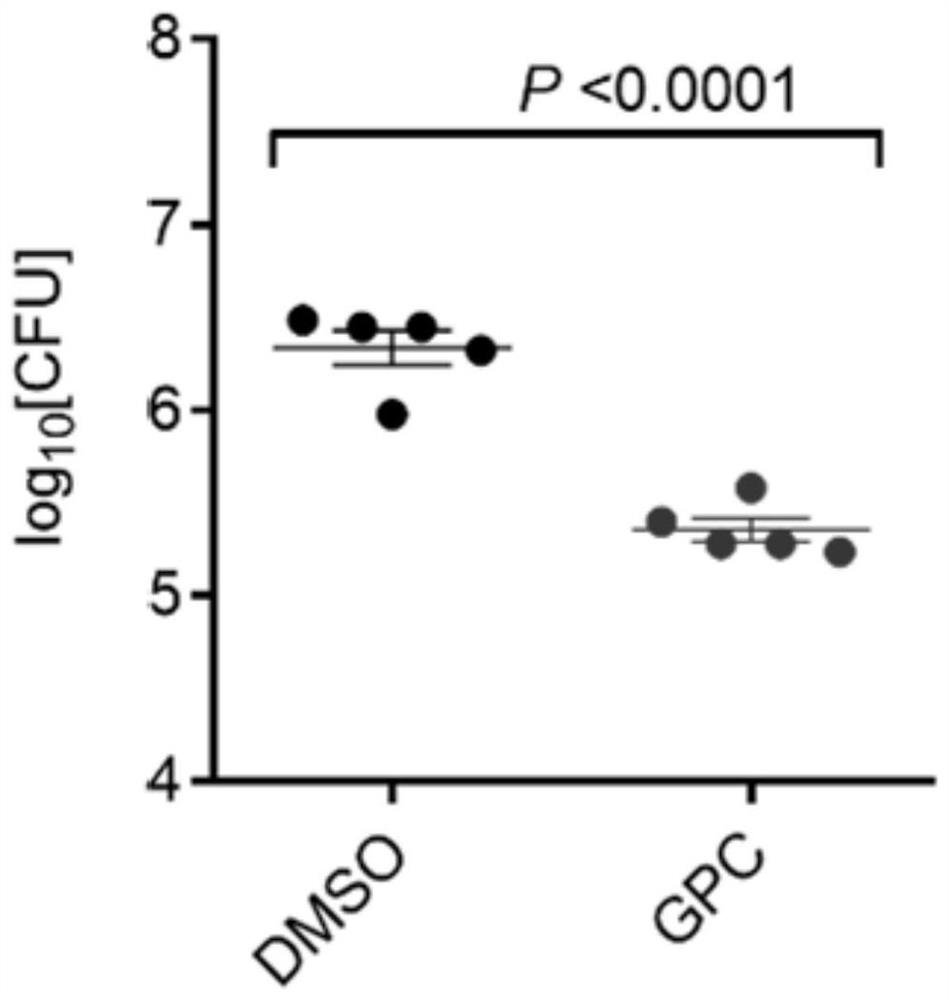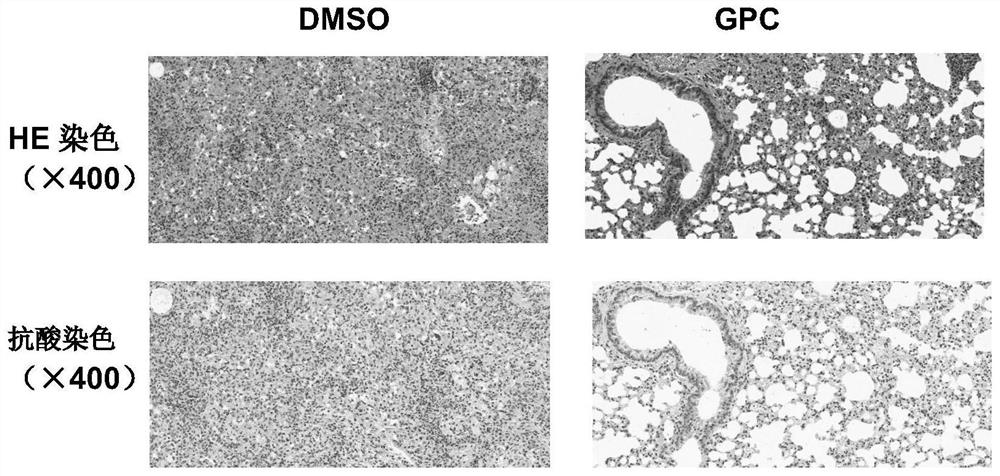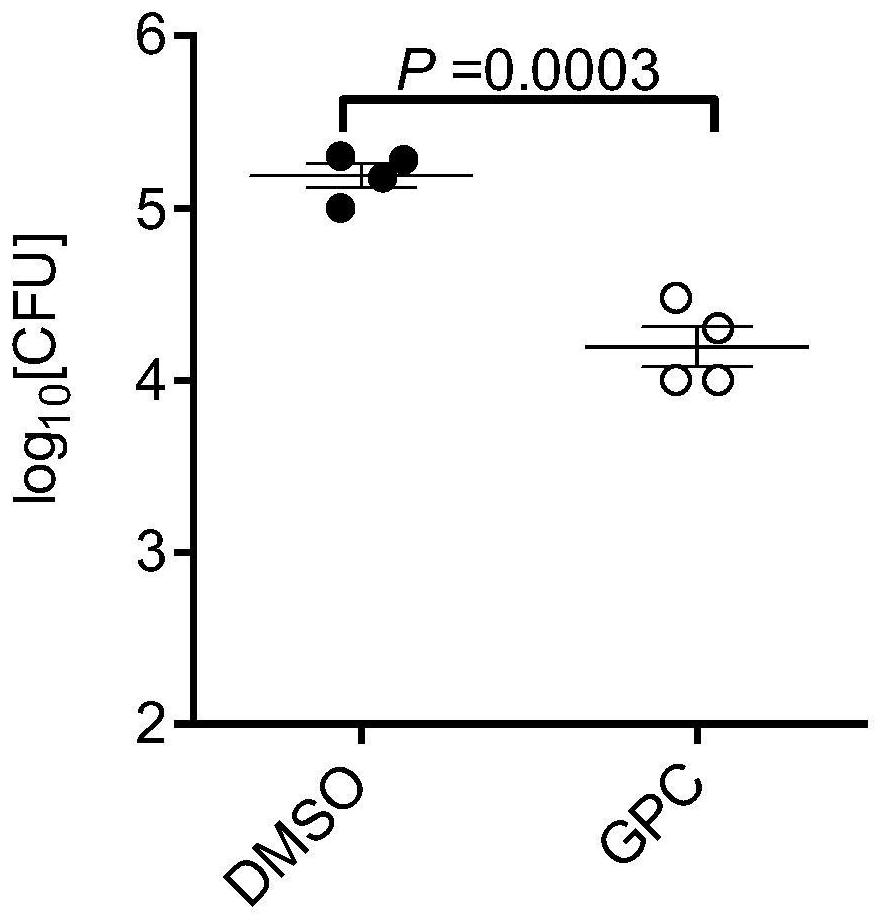Application of glycerophosphorylcholine in preparation of medicines for preventing and treating tuberculosis
A technology for glycerophosphocholine and tuberculosis, applied in the field of biomedicine, can solve the problems of unreported application, unclear function and mechanism, etc., and achieve the effect of inhibiting deterioration and no cytotoxicity
- Summary
- Abstract
- Description
- Claims
- Application Information
AI Technical Summary
Problems solved by technology
Method used
Image
Examples
Embodiment 1
[0031] The present embodiment utilizes the C57BL / 6 mouse infection model to analyze the effect of GPC on tuberculosis. The specific experimental process and results are as follows:
[0032] 6-8 week old female C57BL / 6 mice, 6 in each group, were infected with H37Rv strain by intranasal route, about 200 CFU / mouse. After 3 weeks of infection, the control group was supplemented with 1% DMSO in the drinking water, and the GPC group was supplemented with GPC (1%) in the drinking water, and the mice were sacrificed 4 weeks after the administration. The effect of GPC on tuberculosis was analyzed by detecting the following indicators:
[0033] (1) The amount of bacteria in the organs: collect part of the lungs under sterile conditions, add PBS to homogenize, inoculate on 7H10 agar medium after 10-fold dilution, culture at 37°C for 4 weeks, observe the growth of Mtb, and calculate the amount of bacteria in the lungs , it was found that the amount of bacteria in the lungs infected with...
Embodiment 2
[0037] The present embodiment utilizes the zebrafish infection model to analyze the effect of GPC on mycobacterial diseases, especially granulomas. The specific experimental steps and results are as follows:
[0038] Wild-type zebrafish (AB strain) were obtained from China Zebrafish Resource Center, reared in a recirculating aquaculture system, and transferred to a toxicology system for infection experiments. The standard conditions for zebrafish feeding and infection were ensured that the water temperature was about 28°C, and the pH was about 28°C. 7.4, the conductivity is about 1,500 μS. Adult zebrafish were first anesthetized with 0.1% tricaine, and then infected with Mycobacterium marinum by intraperitoneal injection, with a bacterial count of about 200 CFU. One week later, the control group was orally administered DMSO, and the GPC group was orally administered 0.1 mg / Fish GPC. After 1 week of administration, they were killed, and the effect of GPC on the development of g...
Embodiment 3
[0043] In this example, the in vitro infection model of macrophages was used to analyze the effect of GPC on the survival of intracellular Mtb in macrophages. The specific experimental steps and results are as follows:
[0044] Wild-type mouse peritoneal primary macrophages were taken and cultured in complete 1640 medium (containing 10% FBS + 1% penicillin-streptomycin) at 37°C for 4 hours. After the cells adhered, they were replaced with complete 1640-free medium, and GPC was added. The final concentration was 1 mM, and 12 hours later, H37Rv was infected with MOI=2. After 3 hours of infection, the supernatant was removed, the cells were washed twice with PBS to remove extracellular bacteria, and the number of bacteria entering the cells was counted by CFU. After another part of the cells was washed, 1640 medium containing DMSO or 1 mM GPC was added to continue culturing for 24 hours, and the survival of intracellular bacteria was detected by CFU counting. It was found that G...
PUM
 Login to view more
Login to view more Abstract
Description
Claims
Application Information
 Login to view more
Login to view more - R&D Engineer
- R&D Manager
- IP Professional
- Industry Leading Data Capabilities
- Powerful AI technology
- Patent DNA Extraction
Browse by: Latest US Patents, China's latest patents, Technical Efficacy Thesaurus, Application Domain, Technology Topic.
© 2024 PatSnap. All rights reserved.Legal|Privacy policy|Modern Slavery Act Transparency Statement|Sitemap



